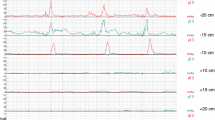Summary
The exact role of the ileocecal valve (ICV) at the junction of small and large bowel is not well understood. Bowel segments used for the construction of urinary reservoirs incorporate the ICV. In the Indiana pouch its natural continence is used as one principle for achieving continence of the efferent limb. Motor activity and pressure in the ICV, the ileum and colon were registered in eight dogs. Myogenic activity of the bowel consisted of slow weves, irregular spontaneous contractions and superimposed spikes. Pressures of 7.2±0.3 cmH2O were recorded in the ileum and of 5.6±0.4 cmH2O in the colon. The pressure in the ICV was 12.7±0.4 cmH2O rising to 26.4±2.2 cmH2O during spontaneous depolarization. Balloon dilatation of the ileum resulted in relaxation of the ICV in 76% of experiments, whereas colonic distension was followed by a pressure increase in the ICV region in 80% of experiments. In 16% of cases a relaxation of the ICV area and a weaker response after repeated dilatation was noted. These findings make the ICV an unreliable continence mechanism as its long-term continence can not be predicted despite intraoperative evaluation. Additional measures to ensure consistent continence at the ICV (e.g. electric stimulation) need to be studied.
Similar content being viewed by others
References
Christensen J, Schedl HP, Clifton JA (1966) The small intestinal basic electrical rhythm (slow wave) frequency gradient in normal men and in patients with a variety of diseases. Gastroenterology 50:309–312
Cohen SL, Harris LD, Levitan R (1968) Manometric characteristics of the human ileocaecal junction zone. Gastroenterology 54:72–75
Elliot TR (1904) On the innervation of the ileocolic sphincter. J physiol (Lond) 31:157–168
Fleckenstein P (1978) Migrating electrical spike activity in fasting human small intestine. Am J Dig Dis 23:769–774
Hirst GDS (1979) Mechanisms of peristalsis. Br Med Bull 35:263–268
Jakobsen H, Steven K, Stigsby B, Larskov P, Hald T (1987) Pathogenesis of nocturnal urinary incontinence after ileocaecal bladder replacement: continuous measurement of urethral closure pressure during sleep. Br J Urol 59:148–152
Kelley ML, Gordon EA, De Weese JA (1965) Pressure studies of the ileocolonic junctional zone of dogs. Am J Physiol 209:333–339
Kock NG, Hulten L, Leandoer L (1968) A study of different parts of the human colon. Scand J Gastroenterol 3:162–169
Pahlin PE (1975) Exrinsic nervous control of the ileocaecal sphincter in the cat. Acta Physiol Scan [Suppl] 426:5–32
Quigley EMM, Philipps SF, Dent J (1984) Distinctive patterns of interdigestive motility at the canine ileocolonic junction. Gastroenterology 87:836–844
Tönnis W (1924) Die Funktion der Valvula ileocaecalis. Arch C Physiol 204:477–482
Vantrappen G, Jannsens J, Covemans G, Jian R (1986) Gastrointestinal motility disorders. Dig Dis Sci 31:5–25
White HL, Rainey WR, Monaghan B, Harris A (1934) Observations on the nervous control of the ilecolonic sphincter and on intestinal movements in an unanaesthetized human subject. Am J Physiol 108:449–457
Author information
Authors and Affiliations
Rights and permissions
About this article
Cite this article
Hofmann, R., Gomez, R., Tanagho, E.A. et al. Motility and intraluminal pressure of the ileocolonic junctional zone and adjacent bowel in a canine model. Urol. Res. 21, 329–332 (1993). https://doi.org/10.1007/BF00296830
Received:
Accepted:
Issue Date:
DOI: https://doi.org/10.1007/BF00296830




